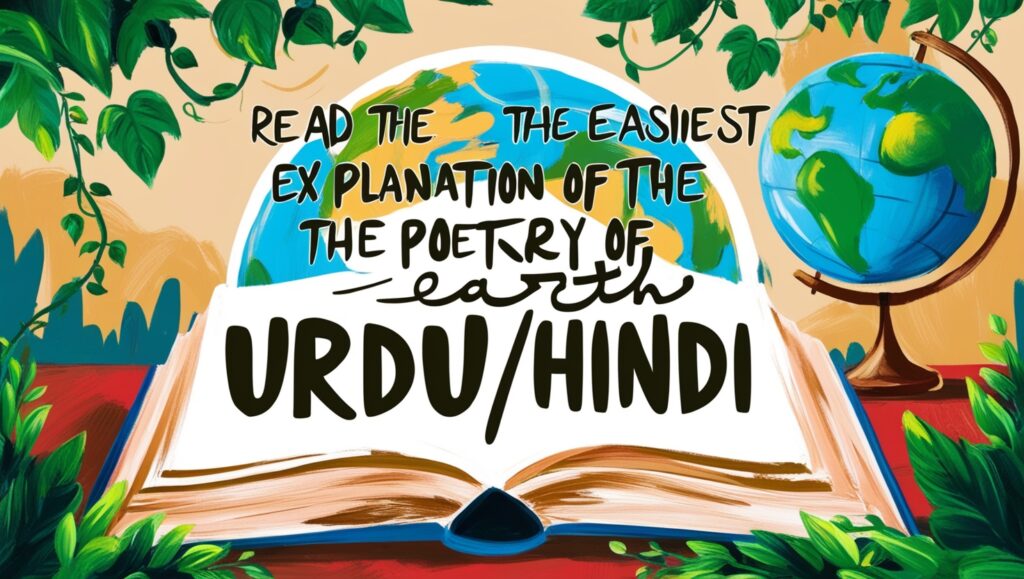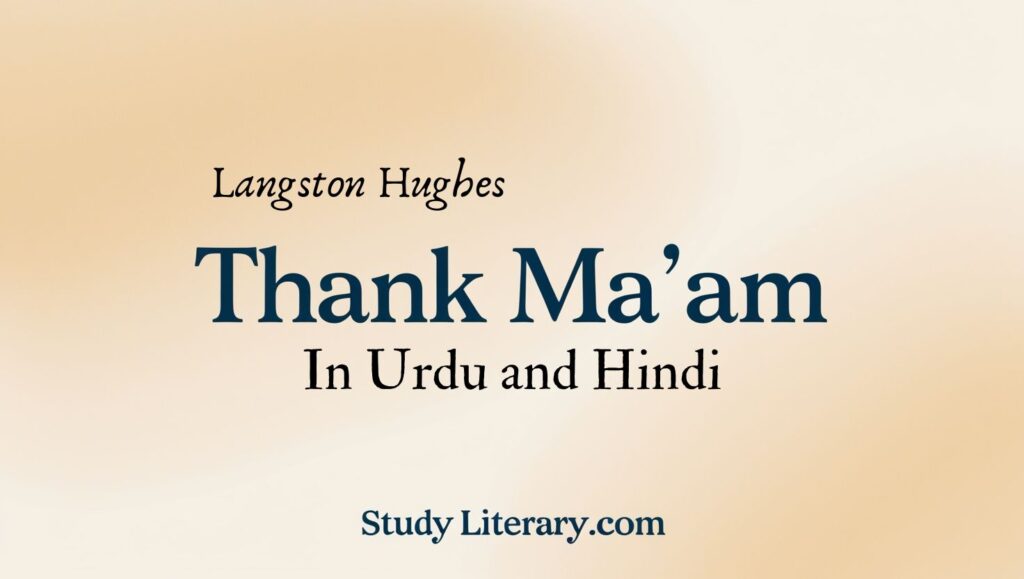The Poetry of Earth in Urdu/Hindi: Here is the 1st Brilliant Ultimate Guide

The Poetry of Earth in Urdu/Hindi focuses on the rich and evocative interpretation of natural themes in these two languages. This concept explores how the beauty and essence of nature are captured and expressed through poetic verses, offering a unique perspective that blends cultural nuances and linguistic beauty. By delving into The Poetry of Earth in Urdu/Hindi, one can appreciate the profound connection between nature and human emotions, conveyed through the melodic and expressive qualities of these languages.
Table of Content
About The Author
John Keats (1795-1821) was a noted poet of the English Romantic Movement. He belonged to the second generation of Romantic poets who came after Coleridge and Wordsworth. He is known for his vivid imagery which are noted for their sensuous appeal. Some of his famous works are Ode to a Nightingale, Hyperion and Isabella.
John Keats (1795-1821) aik mashhoor shayar thay jo English Romantic Movement ka hissa thay. Woh doosri nasal ke Romantic poets mein say thay jo Coleridge aur Wordsworth ke baad aaye. Unki shayari apni roshan tasveerat ke liye mashhoor hai jo apni husn aur khoobsurati ke liye jane jati hain. Unki kuch mashhoor kaam “Ode to a Nightingale,” “Hyperion,” aur “Isabella” hain.
About The Text
The argument put forward by Keats in this poem is that, the natural music of the earth never ceases to play through the cycle of seasons. The poem is a sonnet in which the song of the grasshopper is embodied in the octave and that of the cricket is portrayed in the sestet.
Is nazm/kavita mein, Keats yeh kehtay hain ke zameen ka fitri/prakritik sur/sangeet kabhi rukta nahi, mausam ke chakker ke dauran bhi. Yeh nazm/kavita ek sonnet hai jismein tiddi ki awaz octave mein aur cricket ki awaz sestet mein dikhaayi gayi hai.
The Poetry of Earth in Urdu/Hindi
When all the birds are faint with the hot sun,
Jab har parinda garm dhoop ki wajah se thake aur kamzor hote hai,
And hide in cooling trees, a voice will run
Aur woh darakhton ki thandi chhaaon mein chup jate hain, aik awaaz sunai deti hai jo charo taraf ghoomti hai.
From hedge to hedge about the new-mown mead;
Aik jhaari se dosri jhaari ke charo tarf, taaza kati hui maidan mein,
That is the Grasshopper’s—he takes the lead
Yeh awaaz tiddi ki hoti hai; woh aage ho kar gaata hai.

In summer luxury,—he has never done
Garmiyon ki raahat mein, woh kabhi nahi rukta.
With his delights; for when tired out with fun
Apne he maze se maze uthata hai; kyunke jab woh saari masti se thak jata hai,
He rests at ease beneath some pleasant weed.
Woh aik achay pouday ke neechay araam se baith jata hai.
The poetry of earth is ceasing never:
Fitrat/Prakriti ki khubsurati aur musiqi/sangeet kabhi nahi rukti.
On a lone winter evening, when the frost
Aik sukoon bhari shaam ko sardiyon mein, jab ke barf baari
Has wrought a silence, from the stove there shrills
Har cheez ko khamosh kar deti hai, chulhay se aik tez awaaz sunai deti hai
The Cricket’s song, in warmth increasing ever,
Cricket ka geet, jo garmi mein buland hota jata hai.

And seems to one in drowsiness half lost,
Aur aik shakhs jo aadhi neend mein hota hai
The Grasshopper’s among some grassy hills.
Cricket ka geet sun kar aisa mehsoos karta hai jaise tiddi ka geet ghaas bhari pahaariyon se araha hai.
Additional Resource
The Poetry of Earth Summary in English, Hindi and Urdu
English
In the poem “The Poetry of Earth,” John Keats talks about how nature’s music never stops. He says that during summer, the sound of the grasshopper can be heard all around in fields that have just been cut. The grasshopper seems to enjoy the warm weather and never gets tired of having fun. When it gets tired, it rests comfortably under a plant.
Even in winter, when everything is quiet because of the frost, we can hear the cricket’s song from the warmth of a stove. The cricket’s song gets louder as it warms up, almost like the grasshopper’s song echoing from grassy hills.
Keats believes that nature’s beauty and music are always there, no matter the season. He uses the sounds of the grasshopper and cricket to show how nature continues to sing its songs throughout the year. This reminds us that nature is always around us, providing comfort and joy.
“The Poetry of Earth” is written like a sonnet, a type of poem with fourteen lines. In the first eight lines, Keats talks about the grasshopper’s song in summer. He describes how it fills the air with its cheerful sounds. In the last six lines, he switches to the cricket’s song in winter, showing how it contrasts with the silence around it.
Keats wants us to understand that nature is like a never-ending songbook. It plays different tunes in different seasons, but the music never stops. Whether it’s the lively chirping of the grasshopper in summer or the soothing melody of the cricket in winter, nature’s music is always there to remind us of its beauty.
Hindi
कविता “The Poetry of Earth” में, जॉन कीट्स बताते हैं कि प्रकृति का संगीत कभी नहीं रुकता। वह कहते हैं कि गर्मियों में, हर जगह खेतों में टिड्डे (Grasshopper) की आवाज सुनाई देती है। टिड्डा गर्म मौसम का आनंद लेता है और कभी थकता नहीं। जब वह थकता है, तो आराम से किसी पौधे के नीचे सो जाता है।
सर्दियों में, जब सब कुछ बर्फ से ढका और शांत होता है, तो हम झींगुर (Cricket) की आवाज सुनते हैं। यह आवाज चूल्हे की गर्मी के पास से आती है। झींगुर की आवाज धीरे-धीरे तेज होती जाती है, जैसे गर्मी महसूस करते हुए। यह आवाज टिड्डे की आवाज की तरह सुनाई देती है, जो हरी घास के पहाड़ों से आ रही हो।
कीट्स मानते हैं कि प्रकृति की सुंदरता और संगीत हमेशा हमारे आस-पास होते हैं, चाहे कोई भी मौसम हो। वह टिड्डे और झींगुर की आवाज का उदाहरण देते हुए दिखाते हैं कि प्रकृति सालभर अपना संगीत गाती रहती है। यह हमें याद दिलाती है कि प्रकृति हमें हर समय खुशी और आराम देती है।
“The Poetry of Earth” एक सॉनेट (sonnet) कविता है, जिसमें चौदह पंक्तियां होती हैं। पहले आठ पंक्तियों में, कीट्स गर्मियों में टिड्डे की आवाज के बारे में बात करते हैं, जो चारों तरफ खुशी से गूंजती है। आखिरी छह पंक्तियों में, वह सर्दियों में झींगुर की आवाज का वर्णन करते हैं, जो शांत माहौल में एक मीठी धुन जैसी लगती है।
कीट्स हमें यह समझाना चाहते हैं कि प्रकृति एक ऐसा गाना है जो कभी खत्म नहीं होता। यह हर मौसम में अलग-अलग धुनें बजाती है, लेकिन इसका संगीत कभी रुकता नहीं। चाहे वह गर्मियों में टिड्डे की मस्तीभरी आवाज हो या सर्दियों में झींगुर की शांत धुन, प्रकृति का संगीत हमें हमेशा इसकी सुंदरता का एहसास कराता है।
Urdu
نظم “The Poetry of Earth” میں جان کیٹس بتاتے ہیں کہ قدرت کا میوزک کبھی نہیں رکتا۔ وہ کہتے ہیں کہ گرمیوں میں، ہر طرف کھیتوں میں ٹڈے (گراس ہوپر) کی آواز سنائی دیتی ہے۔ ٹڈا گرمی کے موسم سے خوش ہوتا ہے اور مزے میں رہتا ہے۔ جب وہ تھک جاتا ہے، تو آرام سے کسی پودے کے نیچے لیٹ جاتا ہے۔
سردیوں میں، جب سب کچھ خاموش ہوتا ہے کیونکہ ہر چیز برف سے ڈھکی ہوتی ہے، تو ہمیں چولہے کی گرمی کے پاس جھینگر (کرکٹ) کی آواز سنائی دیتی ہے۔ جھینگر کی آواز گرم ہونے کے ساتھ زیادہ تیز ہو جاتی ہے، جیسے کہ ٹڈے کی آواز پہاڑیوں سے گونج رہی ہو۔
کیٹس مانتے ہیں کہ قدرت کی خوبصورتی اور میوزک ہمیشہ موجود رہتے ہیں، چاہے کوئی بھی موسم ہو۔ وہ ٹڈے اور جھینگر کی آوازوں کا استعمال کرکے دکھاتے ہیں کہ کس طرح قدرت سال بھر اپنی موسیقی گاتی رہتی ہے۔ یہ ہمیں یاد دلاتا ہے کہ قدرت ہمیشہ ہمارے آس پاس ہوتی ہے اور ہمیں سکون اور خوشی دیتی ہے۔
“The Poetry of Earth” ایک سونٹ نظم ہے، جس میں چودہ لائنیں ہوتی ہیں۔ پہلے آٹھ لائنوں میں، کیٹس گرمیوں میں ٹڈے کی آواز کے بارے میں بات کرتے ہیں اور بتاتے ہیں کہ کیسے یہ خوشی سے بھرپور ہوتی ہے۔ آخری چھ لائنوں میں، وہ سردیوں میں جھینگر کی آواز کے بارے میں بات کرتے ہیں اور دکھاتے ہیں کہ یہ خاموشی میں کیسے سکون بخش لگتی ہے۔
کیٹس ہمیں یہ سمجھانا چاہتے ہیں کہ قدرت ایک نہ ختم ہونے والا گیت ہے۔ یہ ہر موسم میں مختلف دھنیں بجاتی ہے، لیکن موسیقی کبھی نہیں رکتی۔ چاہے یہ گرمیوں میں ٹڈے کی چہچہاہٹ ہو یا سردیوں میں جھینگر کی نرم دھن، قدرت کا میوزک ہمیشہ ہمیں اس کی خوبصورتی کی یاد دلاتا رہتا ہے۔
Useful Links
For Translation, Vocabulary and summary
For Questions & Answers, Suggestion
Share
- Facebook
- Twitter
- Linkedin
- Whatsapp
- Telegram
- Pinterest


